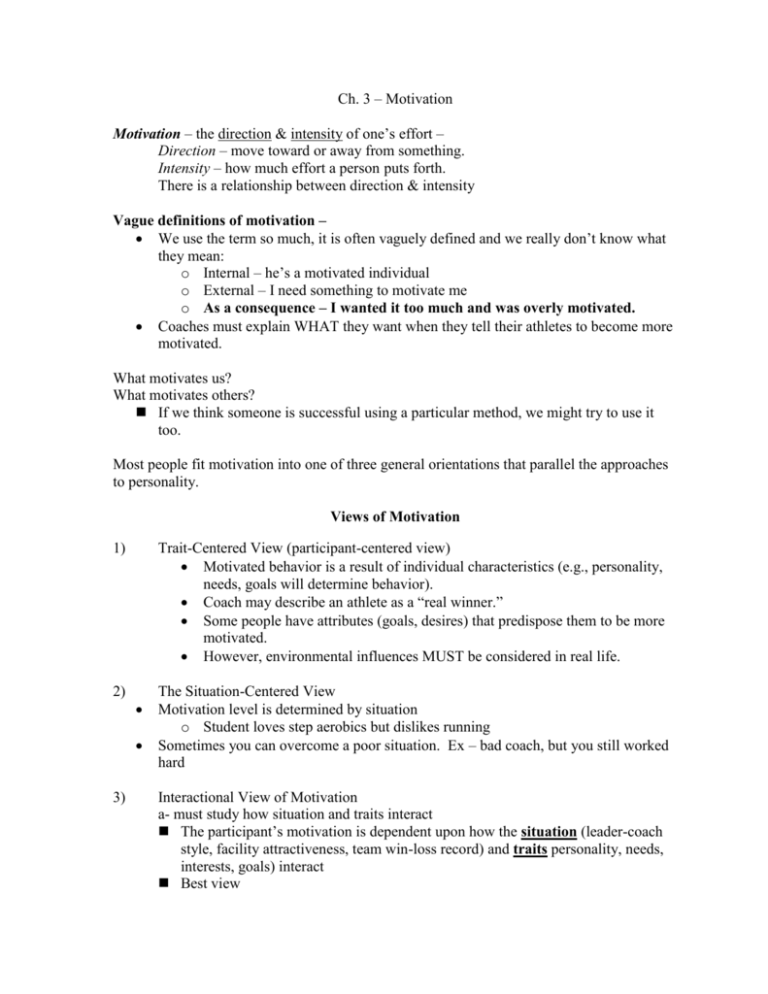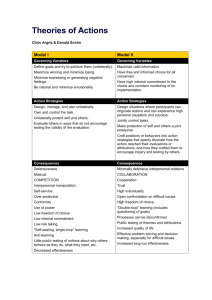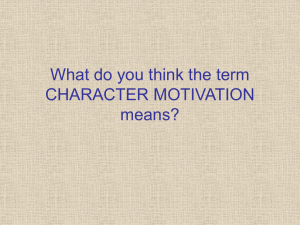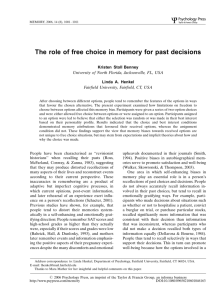Views of Motivation
advertisement

Ch. 3 – Motivation Motivation – the direction & intensity of one’s effort – Direction – move toward or away from something. Intensity – how much effort a person puts forth. There is a relationship between direction & intensity Vague definitions of motivation – We use the term so much, it is often vaguely defined and we really don’t know what they mean: o Internal – he’s a motivated individual o External – I need something to motivate me o As a consequence – I wanted it too much and was overly motivated. Coaches must explain WHAT they want when they tell their athletes to become more motivated. What motivates us? What motivates others? If we think someone is successful using a particular method, we might try to use it too. Most people fit motivation into one of three general orientations that parallel the approaches to personality. Views of Motivation 1) Trait-Centered View (participant-centered view) Motivated behavior is a result of individual characteristics (e.g., personality, needs, goals will determine behavior). Coach may describe an athlete as a “real winner.” Some people have attributes (goals, desires) that predispose them to be more motivated. However, environmental influences MUST be considered in real life. 2) The Situation-Centered View Motivation level is determined by situation o Student loves step aerobics but dislikes running Sometimes you can overcome a poor situation. Ex – bad coach, but you still worked hard 3) Interactional View of Motivation a- must study how situation and traits interact The participant’s motivation is dependent upon how the situation (leader-coach style, facility attractiveness, team win-loss record) and traits personality, needs, interests, goals) interact Best view Participant-by-situation interactional model of motivation The interaction of athlete's motivational style and competitive situation on performance – research example Looked at swimmers for a relay race and each person’s affiliation motivation. If approval oriented (viewing competing with others as a positive thing) – swimmers performed better when part of a team and performs poorer when alone If threatened by rejection (feel threatened by an affiliation-oriented activity)– does better alone and has a lower performance when part of a team Five Guidelines for Building Motivation 1) Both situations & traits motivate people. Easier to change the situation than the trait, but must consider BOTH. 2) People have many reasons for involvement. a) Understand why people participate in physical activity: b) c) d) e) Youth – improve skills, fun, being with friends, experiencing thrills & excitement, achieving success, fitness Adults start exercising – health factors, weight loss, fitness, self-challenge, feel better Adults continue exercising – enjoyment, organization’s leadership, activity, social factors Most people have multiple reasons to exercise May have competing motives – workout vs. time with family People have shared & unique motives Motives change over time – may start due to fitness, but stay because of social aspect 3. Structure the environment to meet needs of participants. a) Provide both competition & recreation b) Provide multiple opportunities c) Adjust to individuals within groups Teaching by invitation Intra-task variation d) Ask students to give information on index cards 4) Leaders influence motivation a) May not know you are being an influence Your personality may be energetic, so you give more reinforcement than others. b) Be honest if you’re having a bad day 5)Use behavior modification to change undesirable participant motives Leader has more control over environment than personality of participants. May need behavior modification to: Change undesirable motives Strengthen weak motivation - - Developing a Realistic View of Motivation it is not the ONLY thing affecting behavior (teams lose because of injury, competition, fatigue, etc. Individuals may have problems that are tied to biomechanical, physiological, medical conditions, etc.) As a leader, recognize that: You are critical to the motivational environment And you influence motivation both directly and indirectly. However, there are limits. You can change reinforcement pattern, but cannot renovate an old building. Achievement Motivation & Competitiveness Why are some individuals motivated while others are not? Achievement motivation – a person’s orientation to strive for success, persist in the face of failure & experience pride in accomplishments. Competitiveness – a striving for satisfaction when making comparisons with some standard of excellence in the presence of evaluative others. Competitiveness is achievement behavior in a competitive context with social evaluation as a key component Achievement behavior –self-comparison or achievement Competitiveness - social evaluation or comparison. Achievement motivation and competitiveness are not just results, they are also the journey. They influence: behaviors, thoughts, feelings (i.e., choice of behavior, effort, intensity, persistence). Motivation also impacts: Choice of activity – opponents of greater or lesser ability Effort to pursue goals (how often do you practice?) Intensity of effort (how hard do you practice?) Persistence in the face of failure – work harder or quit? Theories of Achievement Motivation 1) Needs Achievement is the framework for all contemporary achievement motivation explanations. Its information on task preference and performance predictions is its best contribution. It is made up of: a-personality factors (achieve success of avoid failure) b-situational factors (probability of success and value of success) c-resultant tendencies High achievers like competing in 50-50 situation Low achievers prefer very easy or very hard d- emotional reactions - how much pride or shame does he experience. High achievers – focus on pride; low achievers on shame. e- achievement behavior. High achievers select challenging tasks, prefer intermediate risks, and perform better when they are being evaluated. Low achievers avoid challenging tasks, avoid intermediate risks, and perform worse when they are evaluated. Attribution Theory – focuses on how people explain their successes and failures. Attributions are either: -internal/external (your effort vs. talent of opponents) -stable/unstable (talent vs. luck) -controllable/uncontrollable (your effort vs. sun in your eyes) Attributions influence actions, feelings, confidence, & achievement motivation. Attributions affect expectations of future success or failure and emotional reactions Attributing performance to certain types of stable factors is linked to expectations of future success. Ability high -do it again; ability low – avoid Unstable cause – (luck) won’t impact expectations 2) Outcome Success Failure Pride Confidence Competence Satisfaction Guilt Shame Incompetence Depression Gratitude Thankfulness Luck Anger Surprise Astonishment Gender differences: c) males – internalize success; externalize failure = are able to tackle new and challenging tasks. d) Females – attribute success to external sources (luck) and failure to lack of ability (internal) – leads to learned helplessness. e) Implications – coach athletes to attribute failure to unstable causes that can be expected to change (effort). Egocentrism in Attributions: Athletes are not always completely logical in their attributions Will often engage in illogical or ego-enhancing strategies to explain events Athletes who make self-serving attributions for every event are in danger of losing contact with reality. Coach must provide a dose of reality – their thinking is illogical To a certain extent, self-enhancing and self-protecting strategies are probably good for the athlete’s selfconfidence IF used occasionally. 3) Achievement Goal Theory – three factors interact to determine a person’s motivation: achievement goals (outcome vs. task), perceived ability (high or low), and achievement behavior (performance, effort, persistence, task choice). Task orientation leads to stronger work ethic, less fear of failure. Because focusing on personal performance provides greater control, individuals become more motivated and persist longer in the face of failure. They tend to select moderately difficult or realistic tasks and opponents They do not fear failure. Outcome – have a harder time maintaining high perceived competence. - They judge themselves on how they compare to others – but cannot control how others perform. - If outcome oriented and have low perceived ability will reduce efforts, quit trying, or make excuses. Are more likely to select tasks that they know they can win or know they will lose. - Perform less well in evaluative situations. Importance of motivational climate: - In a climate of mastery or task goal orientation – more adaptive motivational patterns – positive attitudes, increased effort, and effective learning strategies. - In a climate of outcome orientation – less persistence, less effort, and will attribute failure to low ability. Competence Motivation Theory (Harter) – people are motivated to feel worthy and competence and this is the primary determinant of motivation. The feeling of control is also important. Developing Achievement Motivation & Competitiveness 1 Stage – Autonomous competence stage – (> 4yrs.) – child learn to master his environment, self-testing st 2nd Stage – Social comparison stage (age 5)- begins comparing to others 3rd Stage – Integrated stage – involves both social comparison and autonomous achievement strategies – no typical ages for this Implications: Must teach children when it is appropriate or inappropriate to compete and compare with others Must create climates that enhance the attributes that we need Emphasize task goals (downplay outcome goals) Monitor and alter attributional feedback Ex – information vs. effort Assess & correct inappropriate attributions Determine when competitive goals are ok Enhance feelings of competence & control Learned Helplessness - A condition in which people feel that they have no control over their failures and that failure is inevitable. When conditions become difficult, they’ll quit, due to a stable factor (something they cannot change) – ex – not good anyway. Application: Must teach them to give credit to stable factors when they succeed. When fail, attribute cause to unstable causes that can be expected to change, like effort. Later, mix the two, and finally they will begin to use accurate attributions.









